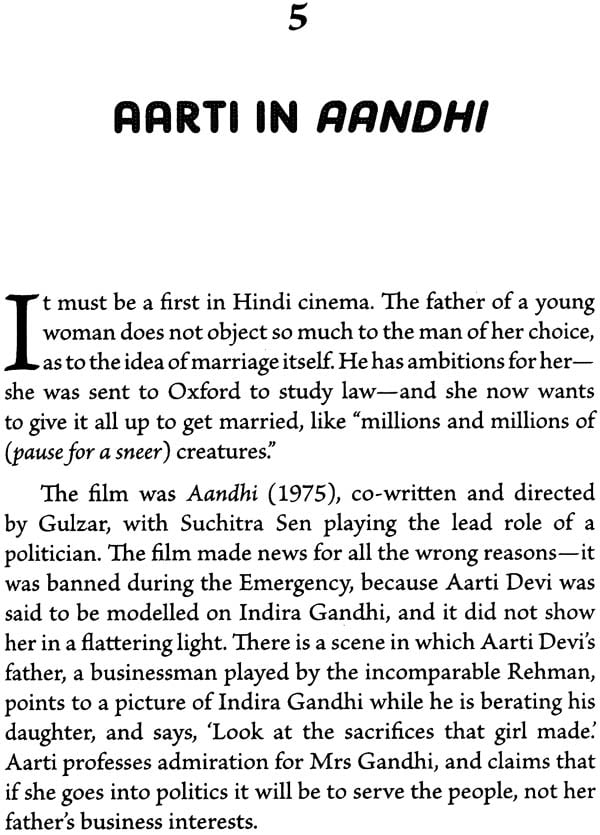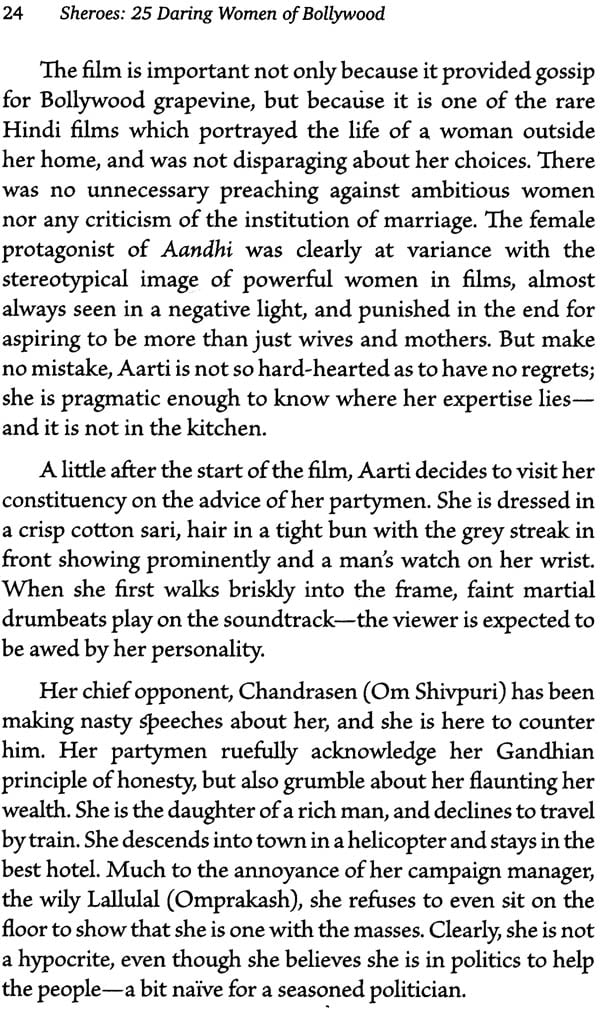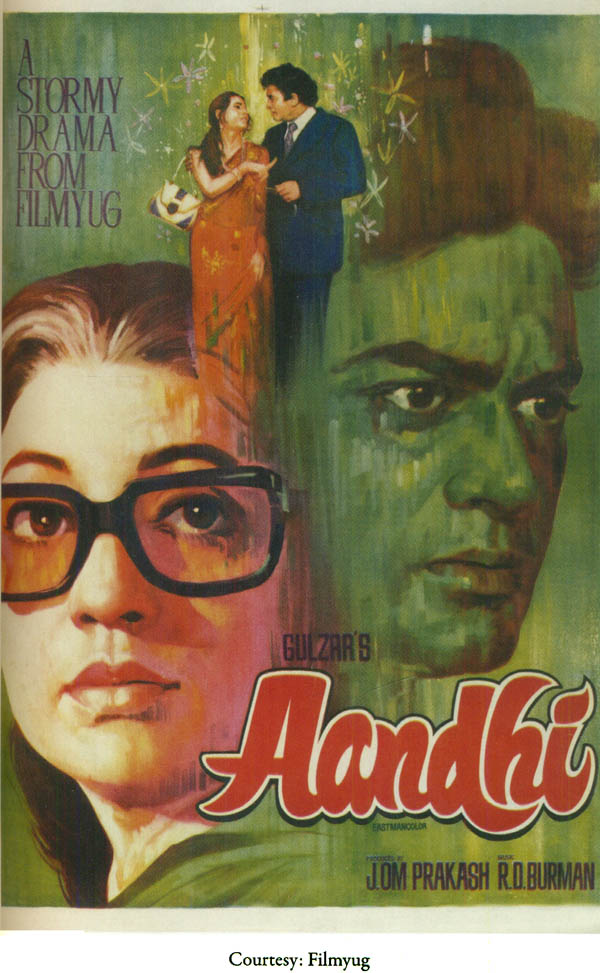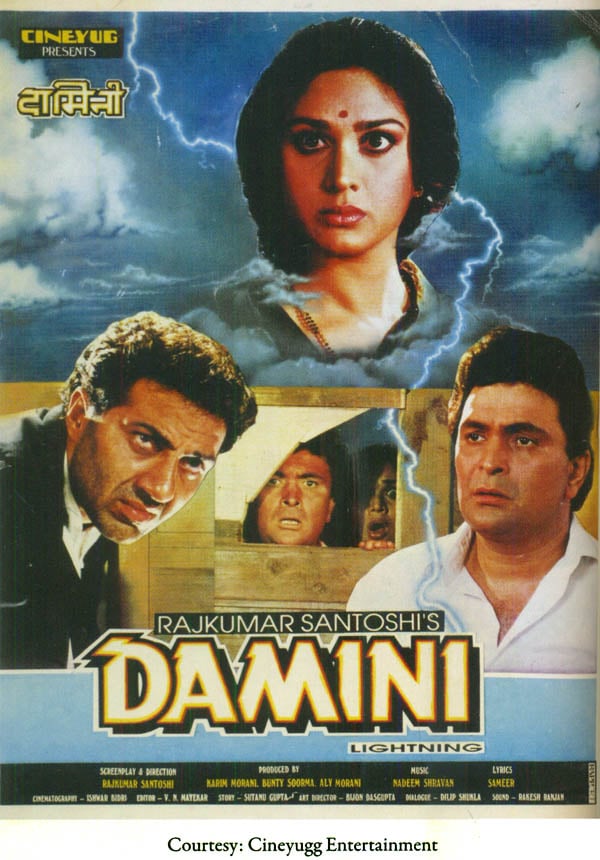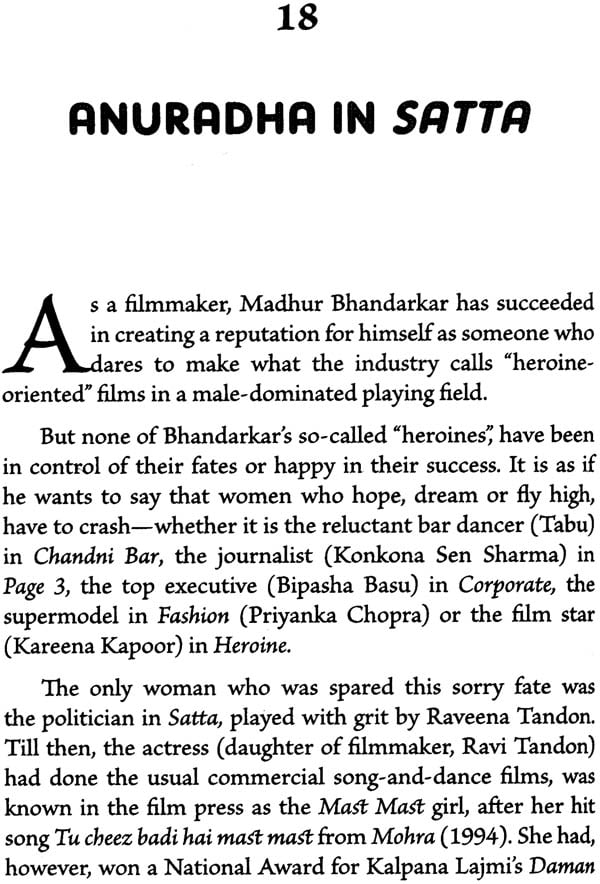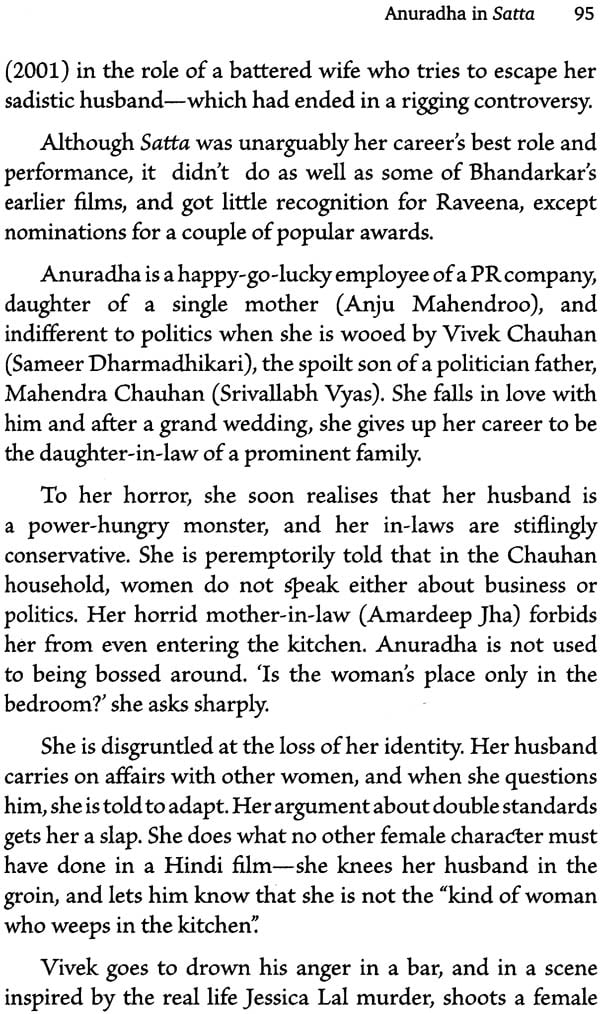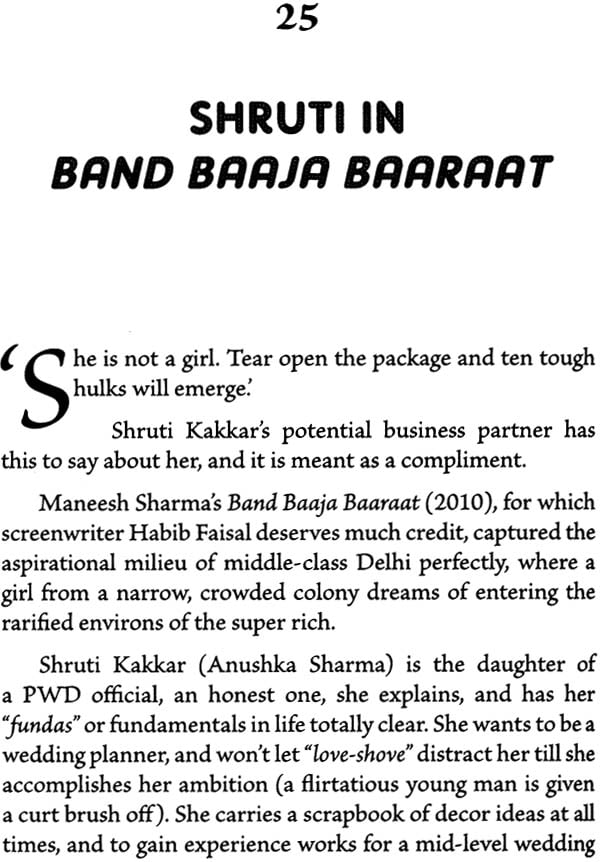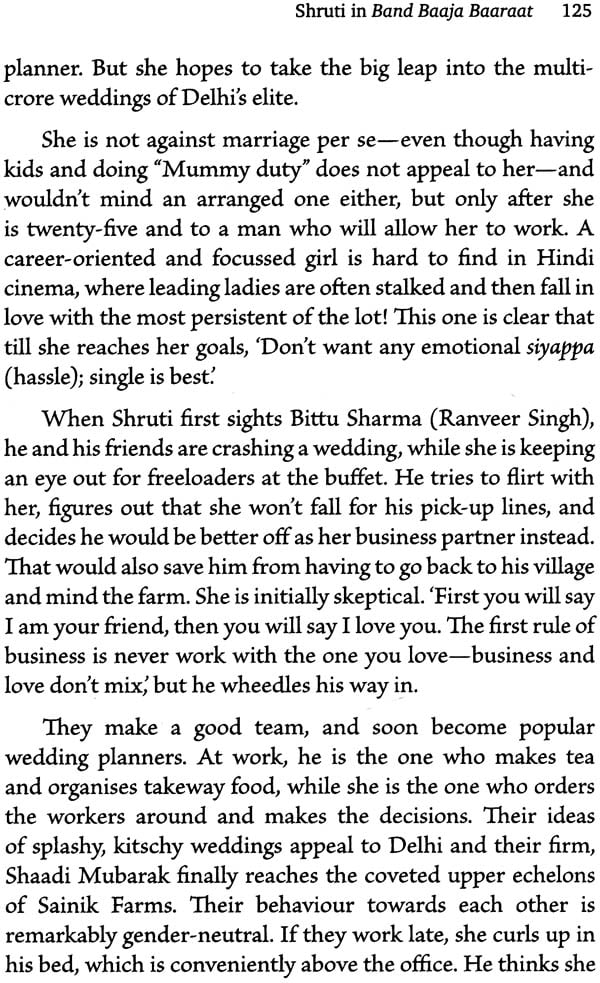
Sheroes: 25 Daring Women of Bollywood
Book Specification
| Item Code: | NAL192 |
| Author: | Deepa Gahlot |
| Publisher: | Westland Ltd. |
| Language: | English |
| Edition: | 2015 |
| ISBN: | 9789385152740 |
| Pages: | 168, (2 B/W and 6 Color Illustrations) |
| Cover: | Paperback |
| Other Details | 7.5 inch x 5.5 inch |
| Weight | 160 gm |
Book Description
Sheroes: 25 Daring Women of Bollywood is a stellar account of heroines in roles that debunk the traditional slots in an industry orchestrated by men and obsessed with the 100 crores phenomenon. From the fiercely independent Rosie (Waheeda Rehman) in Guide; the endearingly impish Manju (Rekha) in Khubsoorat; the feisty Damini (Meenakshi Sheshadri) in the eponymous film; the beauteous yet tenacious Zeenat in Dor, to the ambitious wedding planner, Shruti (Anushka Sharma) in Band Baaja Baarat, these and other actresses in the book took paths that were least travelled yet managed to create benchmarks in Hindi cinema. A mandatory read for every lover of Hindi cinema, Sheroes is pathbreaking as it showcases heroines who explode the stereotypes in a male bastion with incredible chutzpah.
Deepa Gahlot is currently head of film and Theatre at the National Centre for the Performing Arts (NCPA), Mumbai. She continues to write on cinema and enjoys bad films as much as she admires good ones.
She listened to film stories as bedtime tales, and grew up in love with the movies. She has been reviewing films for the better part of a quarter century and the romance hasn’t faded away, though familiarity has been some contempt.
At the outset, I agree that the portrayal of women in Hindi films hasn’t been so great, but they are nevertheless treated better in our films than in society. In countless films, we have seen them as suffering mothers, pativrata (devoted) wives, or sacrificing sisters which in today’s context is stereotyping and an unfair bias At the end of such a film, they are revered as devis, but in real life not even that!
Most filmmakers visualise women in black or white—the traditional domestic goddess or the glamorous sex kitten; a whimpering victim or the aggressive bitch. For instance, the Eighties and Nineties were definitely the worst decades for women in films but even today, Tanu Weds Manu Returns has two women fighting over an unworthy man!
Our television shows are far more regressive and dangerous because they reach women in rural India who live behind ghunghats, and are mandated to follow the diktats of the khap panchayats. I wonder what the shows, portraying evil mothers-in-law and scheming sisters-in-law must do to their minds! Why is it presumed by show directors and producers that the women in village have nothing left to achieve and no ambitions to fulfil? There is of course a reverse phenomenon targeting women like me who were born and raised in a metropolis. The clichéd “modern” woman who smokes and drinks and has sex with a different man every hour is equally ridiculous! Her spirit of independence is somehow equated with the behaviour of a macho man but with a rider that she will be of loose character of crudely put, a slut. Truth be told, I am for neither. I am far too modern to accept the traditional roles reserved for women in cinema, and too old-fashioned for the definition of modernity. Frankly, I am confused and cannot understand either.
One of my all time favourite Hindi films is Seeta Aur Geeta, in which Hema Malini played a double role and was the hero of the film! In fact, I would go so far as to say that Hema Malini is perhaps one of the few heroines who did the least weepy-whining roles in the film industry. Looking back, if I were to ever remake a film, it would be Damini, but I would ensure that she either fights her own battles or has a female lawyer helping her to win the case.
I am often asked why I don’t make women-oriented films and I say, there are already enough men doing it. The only way women can get ahead, and break the glass ceiling is by being successful. All else does not matter. Today’s audiences are looking for more realistic portrayals of women—stronger, empowered, fun loving and not necessarily experts at item numbers! That’s a good sign.
1937: In V Shantaram’s classic, Duniya Ma Mane, a young woman who is conned into marrying an old man, refuses to accept him as her husband.
2014: In Shashank Khaitan’s Humpty Sharma Ki Dulhaniya, a young woman does not have the courage to tell her father about the man she loves and wants to marry.
2015: In Mohit Suri’s Hamari Adhuri Kahani, a married woman describes herself as a man’s milqiyat (property).
It would seem like women in Hindi cinema have come a long way...but walking backwards. The worst traits of the pre-feminist woman seem to have percolated to the present day, but why has there never been another Fearless Nadia in Hindi cinema?
Going by a majority of Hindi films produced over the years, it would be hard to believe that women in India have progressed at all. Although it is also true that the women in cinema have happily discarded the sari for a stringy bikini and prefer to shimmy on an “item number” than sing a bhajan (devotional song), the mindset remains stuck in the past.
What is most surprising is while the educated and empowered woman is busy shattering the glass ceiling in almost every field, Hindi filmmakers, but for a few exceptions, fail to acknowledge the fact. For instance, in one of the most glaring anomalies, female stars are paid a tenth of what their male counterparts make, because although they may be the leading ladies in the films, they are only secondary to the men. And the myth that married actresses and those over thirty (now, maybe thirty-five) can’t attract audience, persists.
Some of the top male stars of today—Salman Khan, Aamir Khan, Shah Rukh Khan, Hrithik Roshan and others—work opposite younger and nubile actresses, primarily because they manage to look hot in bikinis. The girls are mostly interchangeable, and after a few years of staying on the A-List are replaced by younger, sexier actresses. Sadly, it is only on their way down that popular actresses are offered substantial roles. However, actresses like Vidya Balan and Kangana Ranaut, whose films earned the now-mandatory 100 crores, become agents of a pleasant change in the industry. Rani Mukerji, Priyanka Chopra and Parineeti Chopra have also attempted, with limited success, to break the mould. Today’s A-List actresses like Kareena Kapoor, Katrina Kaif, Deepika Padukone (pre-piku) and Sonakshi Sinha add value to their films, but still depend on their leading men’s superstardom for their films’ success. Only Sunny Leone, the former “adult film star” and Bipasha Basu, the self-proclaimed Horror Queen can manage without famous male props.
What is most amazing is that actresses who are considered “accomplished”, have seldom, if ever, done roles that did not fit into the limited slots that the male directors created for them. When Bollywood says a “woman-oriented” film, it means one in which women, suffer, weep , and give their all to preserve the patriarchal family structure, which is uncaring towards them in the first place and does not appreciate those who do not conform to present roles. They may occasionally walk out of marriages or get over loves; but all they want ultimately is the safety of a family and motherhood; if not, society finds ways, of penalising them. At least, now they are no longer expected to be chaste, otherwise for years, the loss of izzat (honour)—another term for rape or pre-marital sex—was good reason to commit suicide and give the macho hero an excuse to take revenge.
From the 1930s to the 1950s, when India was swept by waves of social reforms, mainstream filmmakers like V Shantaram, Raj Kapoor, KA Abbas, Bimal Roy, BR Chopra and a few others made films on progressive themes, some of them with female protagonists.
In Shantaram’s Amar Jyoti (1936), the leading lady (Durga Khote) was a pirate who believed women should fight male oppression. His Duniya Na Mane (starring Shanta Apte, who in real life allegedly thrashed a journalist for writing a nasty piece about her) will always be considered a classic of female empowerment; he made Aadmi (1939) about a policeman falling in love with a prostitute; and Dahej (1950) about the evils of dowry.
In Raj Kapoor’s films (written by KA Abbas), the women were not wallflowers. In one his most well-known films, Awara (1951), Nargis plays a lawyer (before it was trendy for women to have careers), who defends the hero, Raju, on a murder charge; both Nadira as the vamp and Nargis as the heroine in yet another RK Films classic, Shree 420 (1955) had important parts. In the same period, Amiya Chakraborty’s Patita (1953) was about a woman (Usha Kiron), who fights the stigma of rape with the help of a man who loves her (Dev Anand); BR Chopra’s Sadhna (1958) was about the rehabilitation of a courtesan.
Actresses like Nargis, Meena Kumari, Madhubala, Waheeda Rehman, Vyjayanthimala, Nutan were not considered secondary to male stars, and played the central characters in many films; unfortunately the parts they did mostly required them to endure almost superhuman suffering—the epitome of female strength and righteousness was Radha (Nargis) in Mehboob Khan’s classic, Mother India (1957).
It was only a few times in films like Ek Thi Ladki (1949), Chori Chori (1956), Gateway of India (1957), Nau Do Gyarah (1957), and Solva Saal (1958), that heroine was shown as having run away from home, but never far away from rescue and invariably returned to the fold. However, it was a norm that the parts reserved for women were either as the love interest of the hero, or the vamp; the sacrificing mother, the passive wife, the helpmate, muse the reformer of wayward men, or the courtesan. If she was proud (read haughty), she had to be humbled—the taming of the shrew (Aan, Betaab, Himmatwala, Tanu Weds Manu) or feminisation of the tomboy (Nadaan, Upahaar, Kuch Kuch Hota Hai) theme being an eternal favourite; or that of the “fallen” woman rescued by the noble hero!
In the West after the Second World War, the women tasted real freedom by working outside the house and earning a living; they did not agree too easily to be pushed back into the kitchen. The women’s movement was rearing its head, and it was impossible to force women into the role of the traditional housewife as the chorus for equal rights grew louder. Women were slamming the doors of domesticity everywhere and going in search for their identity beyond the home.
But Hindi cinema existed in its own social and cultural cocoon. The more strides women made in real life, the more conservative the films got and women continued to play the victim in many forms. Men were offered complex and nuanced characters, for women it was boringly either black or white. The Strong Male Character was someone who took on the world, while the Strong Female Character was the biggest masochist, one who could go through maximum suffering with the most important agenda of protecting her virtue. Once in a while, Bollywood gifted the hero a vivacious and independent love interest, like Mumtaz as the bioscopewali in Dushman (1972), or Jaya Bhaduri as the knife-sharpener in Zanjeer (1973), and of course Hema Malini as the irrepressible tangewali in Sholay (1975). However, women in Hindi films were seldom independent or exciting; they were invariably bland and beautiful.
Taking the Filmfare Awards as a measure of popular trends over the years, let’s see what kind of roles won a awards for actresses in the lead role category, since the time they started in 1954:
1954: Meena Kumari in Baiju Bawra as the hero’s love interest.
1955: Meena Kumari in Parineeta as a Saratchandra Chattopadhyay heroine who believes she is married to a man because she playfully puts a garland around his neck and goes through much heartache.
1956: Kamini Kaushal in Biraj Bahu as another tragic Sarat heroine who is kidnapped by the villain and escapes his clutches to die at her husband’s feet.
1957: Nutan in Seema as a troubled orphan, who falls in love with the ageing caretaker of the reform home she is sent to and decides to devote her life to him.
1958: Nargis in Mother India as the essence of dutiful and pure Indian womanhood, who kills her outlaw son in the end.
1959: Vyjayanthimala in Sadhna, as Champabai, the nautch girl brought home by the hero to pretend to be his fiancée to please his dying mother, till love strikes and her past comes in the way.
1960: Nutan in Sujata as an Untouchable girl, who is adopted by a Brahmin family; problems arise when an upper caste man falls in love with her.
1961: Bina Rai in Ghunghat as a woman who lands up with the wrong husband following an accident, and goes through much trauma till she is reunited with the right man.
1962: Vyjayanthimala in Gunga Jumna as the woman who stands by the hero who becomes an outlaw due to the zamindar’s (landlord) atrocities.
1963: Meena Kumar in Sahib Bibi Aur Ghulam as the neglected wife of a rich man who turns alcoholic in despair.
1964: Nutan in Bandini as the woman whose unrequited love for a man dictates her entire tragic life.
1965: Vyjayanthimala in Sangam as the woman who loves one man, marries another; his jealousy causes her untold misery.
1966: Meena Kumar in Kaajal as a woman who is married to a man with an ulterior motive, and suffers relentlessly.
1967: Waheeda Rehman in Guide as an ambitious woman, who does not live by social conventions.
1968: Nutan in Milan as an upper class woman whose romance with a poor boatman causes havoc in both their lives; the two are reunited in the next birth.
1969: Waheeda Rehman in Neel Kamal as a woman whose past incarnation haunts her present.
1970: Sharmila Tagore in Aradhana as an unwed mother, whose misfortunes never cease.
1971: Mumtaz in Khilona as a prostitute hired to look after a mad man, who falls in love with her.
1972: Asha Parekh in Kati Patang as a woman deceived in love, who takes shelter with a family pretending to be the widow of their dead son and leaves herself vulnerable to blackmail.
1973: Hema Malini in Seeta Aur Geeta as a set of twins, one meek and the other a hellraiser.
1974: Dimple Kapadia as Bobby, the teenage daughter of a fisherman who falls in love with a rich boy.
1974: Jaya Bachchan in Abhimaan as a singer whose rising popularity causes destructive envy in her singe-husbnad.
1975: Jaya Bachchan in Kora Kagaz as a wife who leaves her husband due to misunderstandings caused by her mother, and lives to regret it.
1976: Lakshmi in Julie as an Anglo-Indian girl who has a child out of wedlock from her Hindu boyfriend and the shame it causes.
| Acknowledgements | ix | |
| Foreword | xi | |
| Introduction | xii | |
| 1 | Geeta in Dr Vidya | 1 |
| 2 | Rosie in Guide | 6 |
| 3 | Saudamini in Lal Patthar | 11 |
| 4 | Mahjubi in Saudagar | 17 |
| 5 | Aarti in Aandhi | 23 |
| 6 | Manju in Khubsoorat | 29 |
| 7 | Pooja in Arth | 35 |
| 8 | Nilofer in Nikaah | 41 |
| 9 | Savitri in Subah | 46 |
| 10 | Malati in Mujhe Insaaf Chahiye | 52 |
| 11 | Laxmi in Pratighaat | 59 |
| 12 | Saraswati in Mirch Masala | 64 |
| 13 | Shanichari in Rudaali | 69 |
| 14 | Damini in Damini | 74 |
| 15 | Ketki in Mrityudand | 80 |
| 16 | Meghna in Dil Se | 85 |
| 17 | Rambhi in Godmother | 90 |
| 18 | Anuradha in Satta | 94 |
| 19 | Sarika in Ek Hasina Thi | 99 |
| 20 | Tamanna in Phir Milenge | 103 |
| 21 | Zeenat in Dor | 108 |
| 22 | Veera Kaur in Dil Bole Hadippa | 112 |
| 23 | Aisha in Wake Up Sid | 117 |
| 24 | Krishna in Ishqiya | 121 |
| 25 | Shruti in Band Baaja Baaraat | 124 |
| 2010 And After | 129 |
